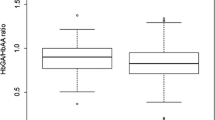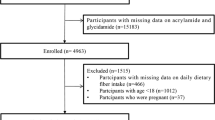Abstract
Background
The validity of epidemiological studies assessing a lifetime cancer risk due to environmental factors, such as nutrition or smoking behavior strongly depends on the validity of the patient’s history.
Objectives
This study assesses whether a standardized questionnaire is a valid tool to identify exposure with acrylamide by relating the self-reported food and smoking history with a biomarker, namely hemoglobin-adduct levels of acrylamide.
Methods
Objective parameters of previous exposure, such as hemoglobin-adduct levels of acrylamide and of the smoking-specific acrylonitrile, respectively, were related to self-reported data in 1,008 volunteers of the general population in bivariate analyses and a multiple linear regression analysis using the log-transformed biomarker levels as outcome.
Results
Smoking was significantly associated with adduct levels of acrylamide (p < 0.0001) and had a main contribution to the internal burden with acrylamide. In cigarette smokers a strong correlation between the number of cigarettes smoked daily and the corresponding biomarkers was observed. Focusing on non-smokers (n = 828), a significant but weak correlation was found in bivariate analyses (Spearman rank correlation coefficient: 0.178 (95% CI: 0.089–0.268) in females and 0.168 (95% CI: 0.063–0.273) in males. A multiple linear regression analysis similarly yielded evidence of a significant association between the highest intake category and adduct levels; however, explained variability was very small (R2 = 0.08).
Conclusion
Self-reported data concerning smoking behavior were highly valid, while self-reported food intake is apparently not as useful for estimating food-related acrylamide exposure.



Similar content being viewed by others
References
Tareke E, Rydberg P, Karlsson P, Eriksson S, Törnqvist M (2002) Analysis of acrylamide, a carcinogen formed in heated foodstuffs. J Agric Food Chem 50:4998–5006
Rice JM (2005) The carcinogenity of acrylamide. Mut Resear 580:3–20
Calleman CJ, Wu Y, He F, Tian G, Bergmark E, Zhang S, Deng H, Wang Y, Crofton KM, Fennell T, Costa LG (1994) Relationship between biomarkers of exposure and neurological effects in a group of workers exposed to acrylamide. Toxicol Appl Pharmacol 126:361–371
Mucci LA, Dickman PW, Steineck G, Adami H-O, Augustsson K (2003) Dietary acrylamide and cancer of the large bowel, kidney, and bladder: absence of an association in a population-based study in Sweden. Br J Cancer 88:84–89
Mucci LA, Dickman PW, Steineck G, Adami H-O, Augustsson K (2003) Letter to the editor. Reply. Dietary acrylamide and cancer risk: additional data on coffee. Br J Cancer 89:774–776
Mucci LA, Lindblad P, Steineck G, Adami HO (2004) Dietary acrylamide and risk of renal cell cancer. Int J Cancer 109:774–776
Mucci LA, Sandin S, Bälter K, Adami HO, Magnusson C, Weiderpass E (2005) Acrylamide intake and breast cancer risk in Swedish women. JAMA 293(11):1326–1327
Mucci LA, Adami HO, Wolk A (2006) Prospective study of dietary acrylamide and risk of colorectal cancer among women. Int J Cancer 118:169–173
Pelucchi C, Franceschi S, Levi F, Trichopoulos D, Bosetti C, Negri E, La Vecchia C (2003) Fried potatoes and human cancer. Int J Cancer 105:558–560
Pellucchi C, Galeone C, Levi F, Negri E, Franceschi S, Salamini R, Borsetti C, Giocosa A, Vecchia CL (2006) Dietary acrylamide and human cancer. Int J Cancer 118:467–471
Doerge DR, Gamboa da Costa G, McDaniel LP, Churchwell MI, Twaddle NC, Beland FA (2005) DNA adducts derived from acrylamide and glycidamide to mice and rats. Mutat Res 580:131–141
Manière I, Godard T, Doerge D, Churchwell MI, Guffroy M, Laurentie M, Poul JM (2005) DNA damage and DNA adduct formation in rat tissues following oral administration of acrylamide. Mutat Res 580:119–129
Männistö S, Virtanen M, Mikkonen T, Pietinen P (1996) Reproducibility and validity of a food frequency questionnaire in a case-control study on breast cancer. J Clin Epidemiol 49:401–409
Brunner E, Stallone D, Juneja M, Bingham S, Marmot M (2001) Dietary assessment in Whitehall II: comparison of 7 d diet diary and food-frequency questionnaire and validity against biomarkers. Br J Nutr 86:405–414
Cade J, Thompson R, Burley V, Warm D (2002) Development, validation and utilization of food-frequency questionnaires––a review. Public Health Nutr 5:567–587
BfR Bundesinstitut für Risikobewertung: 2 Jahre Acrylamid – Eine Bilanz aus der Sicht der Risikobewertung, Stellungnahme vom 19.3.2004 (In German)
Tworoger SS, Hankinsinson SE (2006) Use of biomarkers in epidemiologic studies: minimizing the influence of measurement error in the study design and analysis. Cancer Causes Control 17:889–899
Schettgen T, Weiss T, Drexler H, Angerer J (2003) A first approach to estimate the internal exposure to acrylamide in adults from Germany––smokers and non-smokers. Int J Hyg Environ Health 206(1):9–14
Schettgen T, Kütting B, Hornig M, Beckmann MW, Weiss T, Drexler H, Angerer J (2004) Trans-placental exposure of neonates to acrylamide – a pilot study. Int Arch Occup Environ Health 77(3):213–216
Böning J (2004) Risikoverhalten im Umgang mit Suchtmitteln – Daten und Einblicke in die Behandlung. Gesundheitswesen 66:S71–S79 (In German)
Calleman CJ (1996) The metabolism and pharmacokinetics of acrylamide: implications for mechanisms of toxicity and human risk. Drug Metab Rev 28:527–590
Hagmar L, Törnqvist M, Nordander C, Rosen I, Bruze M, Kautianinen A, Magnusson AL, Malmberg B, Aprea P, Granath F, Axmon A (2001) Health effects of occupational exposure to acrylamide using haemoglobin adducts as biomarkers of internal dose. Scand J Work Environ Health 27:219–226
Decaprio PA (1997) Biomarkers: coming of age for environmental health and risk assessment. Environ Sci Technol 31:1837–1848
Salvini S, Hunter DJ, Sampson L, Stampfer MJ, Colditz GA, Rosner B, Willet WC (1989) Food-based validation of a dietary questionnaire: the effects of week-to week variation in food consumption. Int J Epidemiol 18:858–867
Pufulete M, Emery PW, Nelson M, Sanders TAB (2002) Validation of a short food frequency questionnaire to assess folate intake. Br J Nutr 87:383–390
Feskanich D, Rimm EB, Giovannucci EL, Coldiztz GA, Stampfer MJ, Litin LB, Willet WC (1993) Reproducibility and validity of a self-administered semiquantitative food frequency questionnaire. J Am Diet Assoc 93:790–796
Hebert JR, Clemow L, Pbert L, Oockene IS, Ockene JK (1995) Social desirability bias in dietary self-report may compromise the validity of dietary intake measures. Int J Epidemiol 24:389–398
Zhang J, Temme EHM, Sasaki S, Kesteloot H (2000) Under- and overreporting of energy intake using urinary cations as biomarkers: relation to body mass index. Am J Epidemiol 152:453–462
Heitmann BL, Lissner L (1995) Dietary underreporting by obese individuals––is it specific or non-specific? Br Med J 311:986–989
Lafay L, Mennen L, Basdevant A, Charles MA, Borys JM, Eschwege E, Romon M (2000) Does energy intake underreporting involve all kinds of food or only specific food items. Results from the Fleurbaix Laventie Ville Sante (FLVS) study. Int J Obes Relat Metab Disord 24:1500–1506
Johnson RK, Goran MI, Poehlman ET (1994) Correlates of over-and underreporting of energy intake in healthy older men and women. Am J Clin Nutr 59:1286–1290
Johnson RK, Soultanaskis RP, Matthews DE (1998) Literacy and body fatness are associated with underreporting of energy intake in US low-income women using the multiple-pass 24-hour recall: a doubly labelled water study. J Am Diet Assoc 98:1136–1140
Myers R, Klesges RC, Eck LH, Hanon CL, Klem ML (1988) Accuracy of self-reports of food intake in obese and normal-weight individuals: effect of obesity on self-reports of dietary intake in adult females. Am J Clin Nutr 48:1248–1251
Lissner L, Habich JP, Strupp BJ, Levitsky DA, Haas JD, Roe DA (1989) Body composition and energy intake: do overweight women overeat and underreport? Am J Clin Nutr 49:320–325
Lichtman SW, Pisarka K, Berman ER, Pestone M, Dowling H, Offenbacher E, Weisel H, Heska S, Matthews DE, Heymsfield SB (1992) Discrepancy between self-reported and actual caloric intake and exercise in obese subjects. N Engl J Med 327:1893–1898
Schaefer EJ, Augustin JL, Schaefer MM, Rasmussen H, Ordovas JM, Dallal GE, Dwyer JT (2000) Lack of efficacy of a food-frequency questionnaire in assessing dietary macronutrient intakes in subjects consuming diets of known composition. Am J Clin Nutr 71:746–751
Bingham SA (1991) Validation of dietary assessment through biomarkers. Biomarkers of dietary exposure. In: Kok AP, van’t Veer P (eds) Proceedings of the 3rd meeting on nutritional epidemiology, Smith-Gordon, London pp 41–52
Hagmar L, Wirfällt E, Paulsson B, Törnqvist M (2005) Differences in hemoglobin adduct levels of acrylamide in the general population with respect to dietary intake, smoking habits and gender. Mut Res 580:157–165
Pechacek TF, Fox BH, Murray DM, Luepker RV (1984) Measurement of adolescent smoking behaviour: rationale and methods. J Behav Med 7:123–140
Klesges RC, Debon M, Ray JW (1995) Are self-reports of smoking rate biased? Evidence from the second national health and nutrition examination survey. J Clin Epidemiol 48:1225–1233
Lewis-Esquerre JM, Colby SM, O’Leary Tevyaw TT, Eaton CA, Kahler CW, Monti PM (2005) Validation of the timeline follow-back in assessment of adolescents smoking. Drug Alcohol Depend 79:33–43
Bowlin SJ, Morrill BD, Nafziger AN, Lewis C, Pearson TA (1996) Reliability and changes in validity of self-reported cardiovascular disease risk factors using dual response: the behavioral risk factor survey. J Clin Epidemiol 49:511–517
Acknowledgments
The study was founded by the Bavarian State Ministry of the Environment, Public Health and Consumer Protection. We thank all involved persons from the Bavarian State offices of health and consumer protection and of the local health offices in Bavaria, especially Dr. rer. nat. Ursula Schwegler, for their efforts in recruiting volunteers. Additionally we thank all volunteers of the Bavarian population for participation in this study.
Author information
Authors and Affiliations
Corresponding author
Rights and permissions
About this article
Cite this article
Kütting, B., Uter, W. & Drexler, H. The association between self-reported acrylamide intake and hemoglobin adducts as biomarkers of exposure. Cancer Causes Control 19, 273–281 (2008). https://doi.org/10.1007/s10552-007-9090-9
Received:
Accepted:
Published:
Issue Date:
DOI: https://doi.org/10.1007/s10552-007-9090-9




